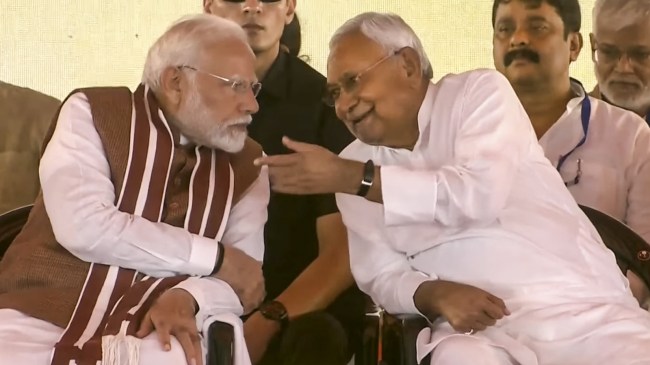Opinion These numbers show how badly JDU-BJP has failed Bihar
It is worth pausing and reflecting on why Bihar lags behind other states. Ideally, a low economic base combined with the much-publicised ‘sushasan’ and double engine should mean Bihar outperforming every competitor
 A government that refuses to provide basic services ends up driving its youth to other states. (PTI)
A government that refuses to provide basic services ends up driving its youth to other states. (PTI) Bridge collapses are a regular event in Bihar. In 2014, construction began for the Rs 1,700 crore Aguwani-Sultanganj bridge. Ten years later, it remains under construction after multiple structural collapses. Corruption, wilful neglect, and faulty policies are often the culprits.
A structural decline of the welfare state is now an omnipresent feature in Bihar. According to Niti Aayog’s SDG India Index 2023–24, Bihar remains the country’s worst-performing state. It ranked worst on several indices: Poverty, hunger, quality of education, and work and economic growth.
It is worth pausing and reflecting on why Bihar lags behind other states. Ideally, a low economic base combined with the much-publicised sushasan and double engine should mean Bihar outperforming every competitor.
Two years ago, the Bihar government published a caste survey, which can be read as its official report card. The survey estimates that 94 lakh families earn less than Rs 200 per day. Poverty is way higher among scheduled castes (43 per cent), scheduled tribes (43 per cent), and extremely backward classes (34 per cent) compared to the general category (25 per cent). Fewer than 10 per cent people have completed their 12th standard, 95 per cent of households do not own a vehicle, and nearly 2.2 crore work as manual labourers.
Bihar’s per capita income (PCI) remains the lowest in India. It features way behind other similarly placed states — one-third of Odisha’s and half of Jharkhand’s. Earlier this year, a CAG report flagged significant financial irregularities in several government departments amounting to over Rs 70,000 crore. Outstanding liabilities increased from Rs 43,000 crore in 2005 to Rs 3,19,000 crore in 2024.
Clearly, money was allocated. Where did it go? Not in improving public services.
One would be pressed to find a functioning school or hospital. Over 20,000 schools lack proper electricity, 76,000 have no computers, and fewer than 2 per cent have digital libraries. School dropout rates among students are highest in India.
Most health centres function without adequate doctors or specialists. In rural community health centres, shortages of medical personnel have reached a high of 90 per cent. Despite being a low-income state, 80 per cent of households prefer avoiding government health facilities citing poor quality of care. There are real human costs to this neglect. Two out of three women are anaemic. Less than 11 per cent of infants receive an adequate diet and over 40 per cent of children under five are stunted.
A government that refuses to provide basic services ends up driving its youth to other states. Ironically, lack of good quality jobs or income opportunities means people aspire to leave their homes in search of a dignified living. Youth unemployment has remained in double digits, and the more educated one is, the harder it becomes to find a job. Almost one in five graduates cannot find employment.
Poor economic performance translates into lack of investments which leads to fewer jobs. Bihar has the lowest industrial employment among major states, with only 1.3 lakh workers employed in the sector, of which just 36,135 are permanent employees. Since 2018–19, employment in factories has increased by only 5,460 workers.
An agrarian state like Bihar requires policies that leverage its strengths and help farmers earn remunerative incomes. A responsive government would have invested in food processing, warehouses, and cold storage facilities. Over the past decade, Bihar has added only 13 cold storages, while Gujarat built 459 and Uttar Pradesh 299.
Bihar has just 899 food processing units employing around 34,700 people, a paltry figure when compared to Punjab’s 3,300 units and 1.5 lakh jobs in the same sector. The inability to convert the farm produce into higher-value products has aided the cycle of impoverishment, leaving makhana, fruit and vegetable farmers despondent and debt-ridden.
Poor law and order are among the major reasons for lack of investments in the state. Earlier this year, noted businessman Gopal Khemka was murdered outside his home in Patna. This is not an exceptional event. In the first half of the year, at least eight prominent businesspersons have faced violent attacks, adding to a climate of fear. Between 2021 and 2023, crime incidents rose by 25 per cent. Bihar now ranks second in the country in cases of murder, dowry deaths, kidnapping, grievous hurt, and motor vehicle thefts.
The state’s crime rate against Scheduled Castes is nearly 50 per cent higher than the national average. Women and children face growing insecurity, as became evident in the Muzaffarpur case where an 11-year-old rape victim died after an inordinate delay in receiving medical care.
Under the present government, Bihar has failed to realise its potential and may have, in fact, regressed on several parameters. All this because policymakers have turned their attention away from inclusive development. Governments are judged by what they do or fail to do for the people that elected them. Two decades after the JD(U)-BJP alliance took over, it is amply clear that their successive governments have failed Bihar and its people.
Kumar and Satyawali are associated with the Congress party







